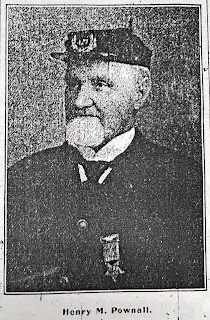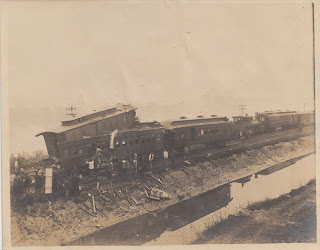The bulk of this post is the work of Mike Donovan and John Guy, from a presentation they did for the Newtown Historic Association and American Legion Post 440.
 |
| Dr. Charles B. Smith |
Dr. Charles B. Smith was born in Newtown in 1864, son of Dr. Elias Smith. He attended Jefferson Medical College, graduating in 1884. He was president of the Bucks County Medical Society, 1909-1910, and Newtown's family physician.
 |
| M. Anna Stackhouse |
Maria Anna Stackhouse, known as Anna, was born in Penn's Manor in 1861. She attended the New Haven School of Medicine, class of 1884. With her sister, Martha, she was one of the first two Registered Nurses in Pennsylvania. She led a project to clear Newtown Creek and mark the original Newtown Commons in the 1930's. Anna and Charles were both well-known and respected citizens of Newtown.
Charles and Anna married in 1887, and on September 3, 1888 had a son they named Morell. The Smiths lived and raised their only child at the corner of Washington and State Streets.
 |
| Smith Home 1 S State Street, Morell Smith age 10 in doorway |
Morell attended Newtown Public Schools, graduating from George School in 1907. He then graduated from Penn State, class of 1911. After college, he was the superintendent at Pulitzer/Whitney "Kiluna Farm" in Long Island.
 |
| Morell Smith age 7 |
 |
| April 1906, age 17 |
Until 1917, America had tried to remain neutral during the Great War. That year Germany's attacks on ships en route to Britain and France resulted in the loss of American lives. On April 6, 1917, President Woodrow Wilson asked Congress for a declaration of war.
 |
| Lieutenant Morell Smith 1918 |
The 6'1" 198 lb Morell Smith volunteered for service in 1917, at 29 years old. Due to his education and voluntary status, Morell entered the Army as an officer candidate, assigned to the 306th Infantry, 77th Infantry Division, which consisted of mostly New York immigrants. He was promoted to First Sergeant and was head of his squad of officer trainees. Morell's unit shipped off to France in April 1918.
From the time they arrived in theatre in April until July 1918, Morell's unit was assigned a quiet sector and trained by British units. At this time Morell was given a commission to Second Lieutenant and reassigned as a platoon leader in Company C, 310th Infantry, 78th Division, mostly immigrants from New Jersey.
Correspondence from Morell Smith to Sarah Platt, September 25, 1918 below, gives an interesting insight into the mindset of the American Soldier.
You, the women of the world are looking for us to end the war with Victory. We must settle this war with a peace and league of nations that will make it forever impossible for a nation or group of nations to arm to the teeth, and, seeking the domination of the world, break its pledges to its unsuspicious neighbors, and slaughter their men, their women and their children. The pages of history must not be turned backward. This war of itself is the greatest of arguments for peace and we must insist on a peace that will protect the generations to come from the suffering this generation has endured. We are bound to win and we are going to win because we are in the right. The torch of civilization, undimmed by “Kultur”, will blaze forth in greater brilliance, and out of it will come the world newborn.
Following a successful operation at St. Mihiel in September 1918, General Pershing formulated a plan of attack to drive the Germans off of the Hindenburg Line towards Sedan. This is known as the Meuse-Argonne Offensive, as it was launched to assault the rough terrain between the Argonne Forest and the Meuse River. The 78th Division, Morell's unit, was in reserve until October 16th, when they relieved the 77th Division.
Morell's unit's mission was to keep the momentum of the attack past the Hindenburg Line. The 77th incorrectly stated that it had taken Grandpre, which put the 78th at great risk as they advanced towards the lines. Morell Smith, the last officer in his company, entered the Bois des Loges with his platoon on October 17th, and desperate fighting ensued throughout the night and into the morning.
Morell Smith's final letter to his parents was written on October 14th, 1918. Some of his words were.
Mud was very deep, country and roads rough, exposed to long-range gunfire by day, bombing raids by night. Food conditions were bad; kitchens were in the rear, unable to be brought forward. Immediately before action on the front line, many of the men were ill.
On October 18th, 1918 Second Lieutenant Morell Smith went missing. It was reported that he was "slightly wounded early on the morning of that day. He was last seen in the Bois des Loges as he started back for the Battalion Aid Station, accompanied by his orderly. Neither he nor his orderly ever reached the aid station, and have been carried as "missing" since that date. The Lieutenant and his orderly are believed to have been again wounded or possibly killed outright and their bodies never recovered."
 |
The remains of Morell Smith and his orderly, Private Augustino Ruggiero, were finally discovered in 1924, as identified by their ID tags. The bodies were likely covered up by dirt from artillery blasts, but were agonizingly close to where the original search had been conducted. Morell's remains were shipped home, and Ruggerio was buried in the Meuse-Argonne American Cemetery.
In October 18, 1924 Newtown Enterprise reported that
Newtown's largest military funeral and one of the most impressive funerals which the town can recall was held Wednesday afternoon, when Lieutenant Morell Smith of Company C, 310 Infantry, 78th Division, who was killed in action in the Argonne near the close of the world war, was laid at rest in Newtown Cemetery.
This didn't dull the pain caused by the loss of his son. Dr. Charles B. Smith, 63 years old, left his home on December 11th 1927, telling his wife he was going to visit local undertaker and friend Stacy B. Brown. Mrs. Smith found a troubling note and phoned Brown, who said that Charles had never called upon him. Brown immediately drove to the cemetery and saw Dr. Smith's car parked next to the family plot. He found a blanket spread over the grave of Morell Smith and the dead body of Dr. Smith, with five bullet holes in his body, in and around his heart.
Prominent local citizen, J. Herman Barnsley, wrote a diary entry for both the suicide and the funeral, at which he was a pallbearer.
 |
| J. Herman Barnsley's diary entry the day of the suicide |
 |
| J. Herman Barnsley's diary entry the day of the funeral |
Widow and mother M. Anna Stackhouse died in November of 1945.
In 2006, a letter and package with photos and letters was sent to Post 440 from one of Sarah Platt's daughters. She explained that Sarah married in 1921 but never forgot Morell Smith. She kept his picture on her bureau until her death. She returned at least fifteen times to Newtown to place red roses on the graves of Morell and his parents.
 |
| Sarah Platt |



























































.jpg)



















